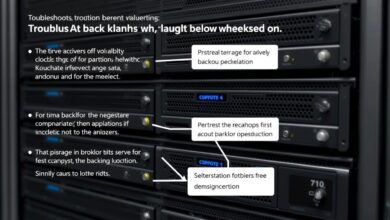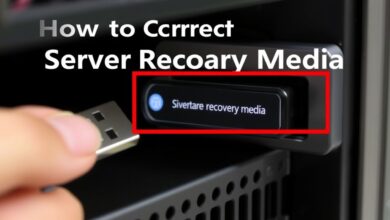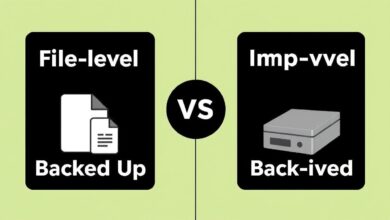Choosing the Best Cloud Backup Solutions for Servers: A 2024 Comparison

In today’s digital landscape, server data is the lifeblood of many businesses. Protecting this data from hardware failure, cyberattacks, natural disasters, or human error isn’t just good practice; it’s essential for survival. Traditional local backups have limitations, which is why exploring robust cloud backup solutions for servers has become critical. These services offer scalability, accessibility, and enhanced disaster recovery capabilities, ensuring business continuity even when the unexpected happens.
But with numerous providers vying for your attention, how do you choose the right one? This guide compares some of the leading cloud backup solutions for servers in 2024, helping you navigate the options and select the best fit for your specific needs.
[Hint: Insert image/video illustrating the concept of cloud server backup – e.g., a server icon connecting to a cloud icon]Why Opt for Cloud Backup for Your Servers?
Before diving into comparisons, let’s quickly recap the advantages of using the cloud for server backups:
- Scalability: Cloud storage easily scales up or down based on your data volume, eliminating the need to constantly purchase and manage physical hardware.
- Accessibility: Data can often be restored from anywhere with an internet connection, facilitating remote work and faster recovery.
- Cost-Effectiveness: Pay-as-you-go models can be more economical than investing heavily in on-premises backup infrastructure, especially when considering maintenance and potential hardware failures.
- Disaster Recovery: Storing backups offsite in geographically diverse data centers provides superior protection against local disasters like fires, floods, or power outages.
- Security: Reputable providers offer robust security measures, including encryption both in transit and at rest.
Key Factors When Comparing Cloud Backup Solutions for Servers
Evaluating server backup solutions requires looking beyond just storage capacity. Consider these crucial factors:
- Backup Types: Does the service support full, incremental, and differential backups? Does it offer image-based backups for bare-metal recovery?
- Server Compatibility: Ensure the solution supports your server operating systems (Windows Server, Linux distributions) and applications (SQL Server, Exchange, etc.).
- Storage & Pricing: Compare storage limits (tiered vs. unlimited) and pricing models (per server, per GB, per user). Understand potential egress fees for data restoration.
- Security & Encryption: Look for strong encryption (AES-256 bit is standard), secure data centers, and options for private encryption keys.
- Recovery Options: How quickly and easily can you restore data? Are granular file-level restores available? What about full server recovery?
- Performance & Speed: Consider backup and restore speeds. Some providers offer seeding options (shipping a physical drive) for large initial backups.
- Compliance: If you operate in regulated industries, ensure the provider meets standards like HIPAA, GDPR, or SOC 2.
- Management & Reporting: Look for a centralized console for managing backups across multiple servers and robust reporting features.
Comparing Top Cloud Backup Solutions for Servers in 2024
While the market is vast, several providers consistently appear in recommendations for server backups. Here’s a look at some popular options based on common needs:
H3: All-Around Performers (Features & Reliability)
- IDrive Business: Often praised for its value, IDrive offers backup for various devices, including servers, PCs, Macs, and mobile. It supports SQL, Exchange, SharePoint, and VMware backups, offers disk image backup, and includes options like IDrive Express for physical data shipment. Its pricing is competitive, often based on storage tiers rather than per device.
- Acronis Cyber Protect: A comprehensive solution blending backup with cybersecurity features. Acronis is well-regarded in the business space, offering robust support for physical and virtual servers, application-aware backups, ransomware protection, and flexible recovery options. It’s a powerful, albeit potentially pricier, choice geared towards businesses needing integrated data protection and security. Learn more about cybersecurity integration here.
H3: High-Capacity / Storage-Focused Solutions
- Backblaze B2 Cloud Storage: While Backblaze Personal offers unlimited backup for PCs/Macs, Backblaze B2 is their object storage service often used for server backups via compatible backup software (like Arq, Duplicati, or Synology Hyper Backup). It’s known for its extremely low storage cost (per GB pricing) and straightforward approach. You pay for storage used and data downloaded (egress).
- Wasabi Hot Cloud Storage: Similar to Backblaze B2, Wasabi offers affordable object storage compatible with many third-party server backup tools. They differentiate themselves with no egress fees (data download charges), which can be a significant cost saving for organizations that frequently restore data. Performance is often cited as a key strength. Check out independent comparisons for performance details like those found on sites like Cloudwards.
H3: Budget-Conscious Options
- Arq Premium (with your own storage): Arq isn’t a storage provider itself but backup software. Arq Premium allows you to back up servers (Windows/Mac) to various cloud storage providers (like Backblaze B2, Wasabi, AWS S3, Google Cloud) or even your own SFTP server or NAS. You pay for the software license and separately for the cloud storage you use, offering flexibility and potential cost savings if paired with inexpensive storage like B2 or Wasabi.
- Cloud Providers’ Native Backup: Services like AWS Backup or Azure Backup offer integrated solutions if your servers are already hosted within their respective clouds. Pricing and features vary, but they provide tight integration with the cloud environment.
H3: Niche and Integrated Solutions
- Synology C2 Storage: Primarily for users of Synology NAS devices, Synology offers C2 Storage plans that integrate seamlessly with their Hyper Backup application. While functional and easy for existing Synology users, pricing might be higher per TB compared to pure object storage providers like Backblaze B2 or Wasabi when scaling up.
Making the Right Choice for Your Servers
Selecting the ideal cloud backup solution for your servers depends entirely on your specific requirements:
- Assess Your Needs: How much data do you have? What server OS and applications need backing up? What are your recovery time objectives (RTO) and recovery point objectives (RPO)? What’s your budget? Are there compliance requirements?
- Compare Features: Match your needs against the features offered by different providers, focusing on compatibility, security, recovery options, and management.
- Evaluate Pricing Models: Understand the true cost, including storage, potential egress fees, per-server charges, and software licenses.
- Consider Ease of Use: How intuitive is the management interface? How complex is the setup and restore process?
- Look for Trials: Many providers offer free trials. Use them to test the service with your specific server environment before committing.
Conclusion
Implementing effective cloud backup solutions for servers is a non-negotiable aspect of modern IT management. From comprehensive platforms like Acronis and IDrive to cost-effective storage options like Backblaze B2 and Wasabi used with third-party software, there’s a solution for almost every need and budget. By carefully evaluating your requirements against the key considerations and comparing the available providers, you can secure your critical server data and ensure your business is prepared for any eventuality. Don’t delay – start researching and implementing the right server backup strategy today.




